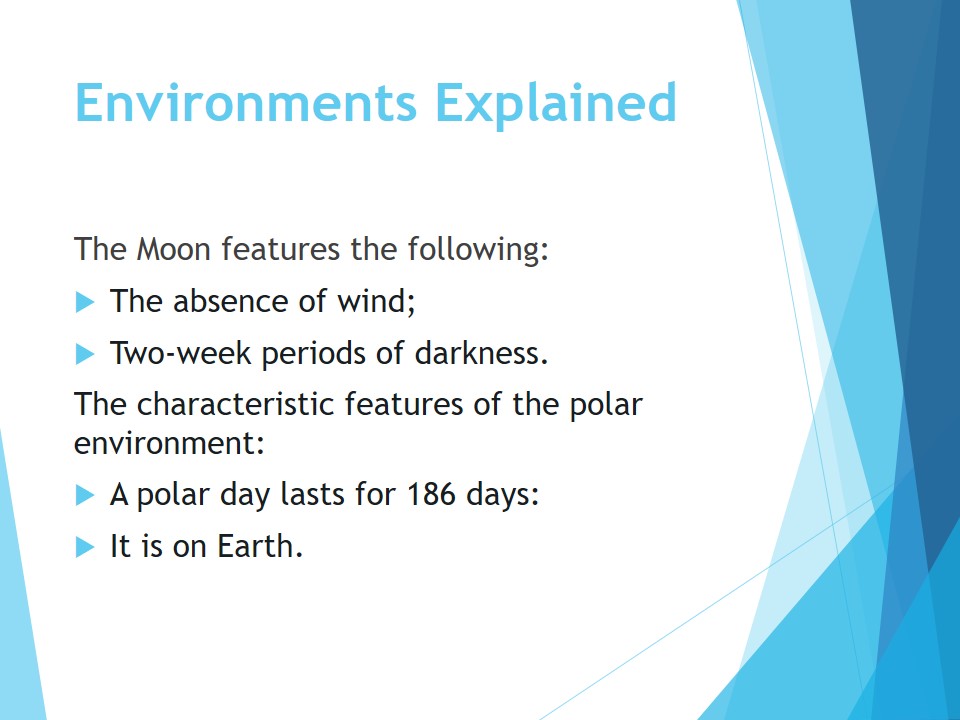Environments Explained
- The Moon features the following:
- The absence of wind;
- Two-week periods of darkness.
- The characteristic features of the polar environment:
- A polar day lasts for 186 days:
- It is on Earth.
When choosing suitable types of power sources for a rover, it is necessary to define environmental conditions where it is expected to operate. As for the Moon, this satellite does not have wind, and one could not use wind energy for such rovers. Furthermore, lunar days and nights last for two weeks, which implies its consequences. When it comes to the polar environment, a polar day lasts there for more than half a year. Finally, this territory is on Earth, which means that such a rover does not lose much energy to reach it. These conditions imply their requirements and limitations while choosing a power source.

Solar Energy
- Renewable source of power (Agarwal & Mishra, 2016).
- Low cost.
- Dependence on resources.
- Degradation of solar batteries.
Solar energy is considered the most popular variant for rovers. According to Agarwal and Mishra (2016), it is so because this source of power is renewable due to constant sun rays. Furthermore, solar energy is requested now because it is relatively cheap. However, this information does not mean that this source of power is free from any drawbacks. Firstly, it refers to the fact that no one can control the Sun, and if its rays fail to reach the rover for a certain period, it will not work. Secondly, it is stated that solar batteries tend to degrade and make it impossible “to recharge to full power capacity” (Agarwal & Mishra, 2016, p. 1711).

Nuclear Energy
- Long-living source of power.
- Insensitive to the space environment.
- These batteries are rugged and compact.
- Relatively high cost.
Nuclear energy is becoming more requested in the modern world because of its advantages. Firstly, it is a long-living source of power, which makes it a suitable variant for long missions (Agarwal & Mishra, 2016). Secondly, this energy source does not depend on the environment and works irrespectively of external conditions. Thirdly, such batteries are rugged and compact, which makes it convenient to use them. Finally, Agarwal and Mishra (2016) do not indicate any of their disadvantages, but a relatively high cost is said to be the most significant among them. This information means that nuclear energy is the second most popular source of energy for rovers after solar one.

Choosing a Suitable Source of Power
- Solar energy is suitable for polar rovers.
- Moon rovers benefit from nuclear energy.
Based on the analysis of the present information, one can note that different sources of power are suitable for different environments. On the one hand, if a rover is going to be sent to the polar climate during a polar day, it is reasonable to equip it with solar arrays. This area of the planet will have a sufficient amount of sun light to make the rover perform its mission. On the other hand, nuclear energy offers significant benefits for moon rovers. It refers to the fact that this device will not require any external factors to work and cope with its mission. Thus, it is necessary to choose the right source of power to reckon on positive results.

Conclusion
- Various power sources imply their peculiarities.
- The environment determines a power source.
- A power source should meet the environment.
Various sources of power can be used in rovers, and each of them implies its own peculiarities. Solar energy is a cheap energy source that can be renewed thanks to the sunlight, while nuclear energy provides rovers with an independent source of power to participate in long-term missions. If one wants to determine which kind of power is more suitable for a particular machine, it is necessary to analyze the environmental conditions where it is going to perform. One should draw specific attention to the availability of sunlight. One can suppose that it is impossible to reckon on a positive result of a mission if a wrong source of power has been chosen.

Reference
Agarwal, P., & Mishra, J. (2016). Power sources for rovers. International Journal of Science and Research (IJSR), 5(11), 1710-1715.


